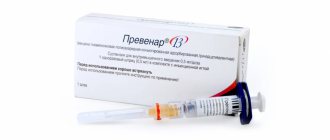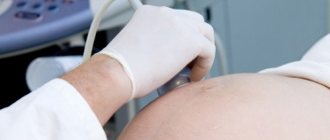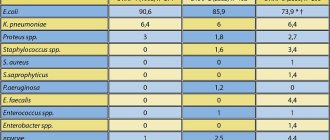Pharmacological properties of the drug Lamivudine
Antiviral agent. Penetrating into cells, it is phosphorylated to 5-triphosphate, which inhibits DNA- and RNA-dependent reverse transcriptase of HIV, which leads to inhibition of viral replication. It is active against tsidovudine-resistant strains, and when used in combination with tsidovudine, it slows down the development of viral resistance to tsidovudine in patients who have not previously received treatment. It has a higher therapeutic index in vitro ; It inhibits precursor cells in the bone marrow less strongly than cidovudine, and also has a less pronounced cytotoxic effect on peripheral blood lymphocytes, lymphocytic and monocyte-macrophage cell lines. It has little effect on the metabolism of cellular deoxynucleotides and the DNA content in the mitochondria of undamaged cells.
Description of the drug LAVUDIN-AB
Carriage of the HLA-B*5701 allele significantly increases the risk of developing a hypersensitivity reaction to abacavir. The clinical trial CNA106030 (PREDICT-1) showed that hypersensitivity reactions to abacavir develop in patients carrying the HLA-B*5701 allele at a rate of 48-61% compared with patients who do not have this allele (incidence of hypersensitivity reactions 0 -4%).
Clinicians are advised to screen for carriage of the HLA-B*5701 allele in HIV-infected patients who have not previously been prescribed abacavir-containing medications. Screening for carriage of the HLA-B*5701 allele is recommended before re-prescribing an abacavir-containing drug in patients with unknown HLA-B*5701 status who previously tolerated therapy with an abacavir-containing drug. The use of abacavir drugs is not recommended in such patients and should be considered only in exceptional cases with careful medical supervision when the expected benefit outweighs the potential risk.
The clinical diagnosis of a suspected hypersensitivity reaction should remain the basis for the decision to use abacavir-containing products in all patients. Even in the absence of the HLA-B*5701 allele, abacavir should be discontinued and not restarted in all cases where a hypersensitivity reaction cannot be ruled out based on clinical evidence, due to the potential risk of serious adverse effects or even death.
Some hypersensitivity patients initially believed they were suffering from respiratory (pneumonia, bronchitis, pharyngitis) or influenza-like illnesses, gastroenteritis, or a reaction to other medications. In this regard, the hypersensitivity reaction was not immediately diagnosed, and patients continued (or resumed) taking the drug. This entailed the development of a more severe hypersensitivity reaction (even death). Taking this into account, it is necessary to take into account the possibility of developing such a reaction and exclude it in patients who have symptoms of these diseases.
Symptoms due to a hypersensitivity reaction increased with continued treatment and usually disappeared after discontinuation of abacavir.
Restarting abacavir after a hypersensitivity reaction within a few hours results in a rapid return of symptoms. A relapse of a hypersensitivity reaction may be more severe than the first reaction and be accompanied by a life-threatening decrease in blood pressure (even death).
There are isolated reports of the development of a hypersensitivity reaction after resuming abacavir, which was discontinued when certain key symptoms of hypersensitivity appeared (rash, fever, weakness/malaise, gastrointestinal disorders or respiratory symptoms). In very rare cases, the development of a hypersensitivity reaction has been reported after resumption of the drug in patients who had not previously experienced symptoms of hypersensitivity.
Patients, regardless of HLA-B*5701 status,
Anyone who develops signs and symptoms of hypersensitivity should immediately contact their physician for advice. If hypersensitivity is diagnosed, you should immediately stop taking the drug. Treatment with abacavir + lamivudine and other medicinal products containing abacavir should never be restarted after a hypersensitivity reaction has occurred. This is due to the risk of severe symptoms appearing within a few hours after resuming taking the drug, which can be fatal.
To prevent delayed detection and reduce the risk of developing life-threatening hypersensitivity, you should completely stop taking the drug if hypersensitivity cannot be ruled out, even in the potential presence of other diseases (respiratory diseases, influenza-like illnesses, gastroenteritis, reactions to other medications). Treatment with the combination of abacavir + lamivudine and other medicinal products containing abacavir should not be restarted, even if symptoms of hypersensitivity occur when re-taking other medicinal products.
If treatment with the drug is discontinued, regardless of carriage of the HLA-B*5701 allele, before resuming the drug, the reason for stopping the drug should be carefully examined and the patient has no symptoms of a hypersensitivity reaction. You should not resume taking the combination of abacavir + lamivudine and other drugs containing abacavir if a hypersensitivity reaction cannot be ruled out.
A few cases of the development of a hypersensitivity reaction have been described when treatment with abacavir is resumed after its discontinuation due to the appearance of any one of the typical symptoms of hypersensitivity (rash, fever, malaise, fatigue, gastrointestinal disorders and disorders of the respiratory system). Since in all such cases a hypersensitivity reaction cannot be excluded and, taking into account data on its more severe course with repeated use of abacavir, resumption of therapy with the combination of abacavir + lamivudine or another abacavir-containing drug in these patients is not recommended.
Hypersensitivity reactions have been reported, although extremely rarely, even when treatment with this drug is restarted in patients who had not previously experienced symptoms of this reaction, and interruption of abacavir-containing drugs has been associated with other reasons. In this case, resumption of the drug is possible, but requires that the patient or people around him have quick access to medical care.
Screening for carriage of the HLA-B*5701 allele is recommended before re-prescribing an abacavir-containing drug in patients with unknown HLA-B*5701 status who previously tolerated therapy with an abacavir-containing drug.
Repeated administration of a drug containing abacavir to patients carrying the HLA-B*5701 allele is not recommended and should only be considered in exceptional cases under close medical supervision, when the expected benefit of treatment with the drug outweighs the potential risk.
With the use of antiretroviral nucleoside analogues (including abacavir and lamivudine), taken either individually or in combination, the development of lactic acidosis, hepatomegaly and severe fatty liver disease, including cases resulting in death, was noted. Similar phenomena were observed mainly in women.
Clinical signs of developing lactic acidosis are general weakness, anorexia, sudden causeless loss of body weight, symptoms of damage to the respiratory system (shortness of breath, rapid breathing) and gastrointestinal tract.
Caution should be exercised when prescribing the drug to all patients, especially those who have risk factors for liver damage. The drug should be discontinued if clinical or laboratory signs of lactic acidosis or hepatotoxicity (which include hepatomegaly and steatosis) appear, even in the absence of a significant increase in aminotransferase activity.
Some patients who received combination antiretroviral therapy experienced redistribution/accumulation of adipose tissue in the body, an increase in the amount of adipose tissue on the back of the neck and back (“buffalo hump”), a decrease in the amount of peripheral fat deposits, a decrease in the subcutaneous fat layer on the face, enlargement of the mammary glands, increased concentrations of glucose and lipids in the serum.
Lipodystrophy can develop when taking any drugs from the class of protease inhibitors or nucleoside reverse transcriptase inhibitors. However, available evidence suggests that the risk of developing these side effects varies among different drugs in these classes. In addition, many factors contribute to the development of lipodystrophy. The presence of HIV infection, advanced age and duration of antiretroviral therapy play an important and possibly mutually potentiating role.
During the clinical examination, attention should be paid to signs of redistribution of fat in the body. Serum lipids and blood glucose concentrations should be closely monitored. If necessary, appropriate treatment for lipid metabolism disorders is carried out.
Clinical studies and post-marketing data with lamivudine suggest that some patients with concomitant hepatitis B virus (HBV) infection may develop clinical or laboratory evidence of relapse of hepatitis after discontinuation of lamivudine. Discontinuation of lamivudine may have more severe consequences in patients with decompensated liver disease. As a result, in patients with concomitant viral hepatitis B, when discontinuing the abacavir + lamivudine combination, liver function tests should be monitored and the level of hepatitis B virus replication should be regularly determined.
If HIV-infected patients with severe immunodeficiency have asymptomatic or minimally symptomatic opportunistic infections at the time of initiation of antiretroviral therapy, such therapy may lead to increased symptoms of opportunistic infections or other serious consequences. These reactions usually occur within the first weeks or months after starting antiretroviral therapy. Typical examples are cytomegalovirus retinitis, generalized or focal infection caused by mycobacteria, and pneumonia caused by Pneumocystis jiroveci. The appearance of any symptoms of inflammation requires immediate examination and, if necessary, treatment.
The use of abacavir + lamivudine or other antiretroviral drugs does not exclude the possibility of developing opportunistic infections or other complications of HIV infection, so patients should remain under the supervision of a physician experienced in treating these diseases.
Current antiretroviral therapy does not prevent HIV transmission through sexual contact or contact with infected blood. Please remember to follow appropriate safety precautions.
A prospective observational epidemiological study examining the incidence of myocardial infarction in patients receiving combination antiretroviral therapy found an association of prior abacavir use within 6 months with an increased risk of myocardial infarction. According to a pooled analysis of clinical studies, there was no increase in the risk of myocardial infarction associated with taking abacavir. The biological mechanisms explaining the potentially increased risk are unknown. Available data from observational cohorts and controlled clinical trials do not allow us to definitively determine the relationship between abacavir therapy and the risk of myocardial infarction. However, caution should be exercised when prescribing antiretroviral therapy, including drugs containing abacavir, to patients at possible risk of coronary artery disease. Measures should be taken to minimize risk factors (such as hypertension, dyslipidemia, diabetes mellitus and smoking).
Impact on the ability to drive vehicles and machinery
There have been no special studies of the effect of lamivudine on the ability to concentrate when driving vehicles/machines. The drug is unlikely to adversely affect the ability to perform tasks requiring alertness, motor or cognitive skills. However, when assessing a patient's ability to concentrate, one should take into account his general condition, as well as the nature of the side effects that may occur while taking the drug.
Use of the drug Lamivudine
Adults and adolescents are prescribed 150 mg 2 times a day (in combination with cidoudine at a dose of 600 mg/day, divided into 2 or 3 doses). Children are prescribed at the rate of 4 mg per 1 kg of body weight 2 times a day (in combination with cidovudine at a dose of 360–720 mg/m2/day, divided into several doses). The maximum daily dose of lamivudine is 300 mg, cidovudine is 200 mg every 6 hours. In patients with renal failure, the dosage regimen must be adjusted taking into account creatinine clearance: at a level of more than 30 ml/min, lamivudine is used at a dose of 150 mg once a day; at a level of 5–30 ml/min - periodically at a dose of 150 mg 1 time per day.
| Dovato is a complete antiretroviral therapy regimen containing two active ingredients in a single tablet, administered once daily, significantly reducing the drug burden on people living with HIV. |
GSK announced that it has received a marketing authorization for the drug Dovato (dolutegravir 50 mg/lamivudine 300 mg) in the Russian Federation. Dovato is a combination medicinal product consisting of two components and is a complete antiretroviral therapy (ART) regimen in the form of one tablet taken once daily for the treatment of infection caused by HIV-1 in adults and adolescents over 12 years of age weighing at least 40 kg, with no known or suspected resistance to integrase inhibitors (InIs) or lamivudine 1 . Svetlana Klimenko, PhD, medical director of GSK Pharma Russia: “The registration of the innovative drug Dovato is an important event for people living with HIV (PLHIV) in our country, because this will change the paradigm of HIV treatment. Dovato is a complete two-drug regimen that has demonstrated long-term efficacy and safety comparable to three-drug regimens 2 - 3 and is based on dolutegravir, the most prescribed integrase inhibitor in the world 4 . All this makes it possible to fully meet the needs of PLHIV in the treatment of HIV infection by reducing the number of medications taken while maintaining the effectiveness of therapy.” Earlier, in June 2022, within the framework of the St. Petersburg International Economic Forum (SPIEF), GSK and Servier signed a joint statement on the possibilities of producing the drug Dovato at the Moscow production complex Servier RUS. In Russia, on average, more than 80,000 new cases of HIV infection are diagnosed annually 5 . In 2022, more than 100,000 Russian HIV-infected citizens were enrolled in antiretroviral therapy for the first time 6 . HIV infection is considered a chronic disease, which means that ongoing antiretroviral therapy is required throughout life. Currently, the European AIDS Clinical Society (EACS)* and US Department of Health and Human Services (DHHS)** HIV clinical guidelines recommend dolutegravir+lamivudine as the preferred option for initiating antiretroviral therapy in the majority of PLHIV. and for patients with sustained virological suppression 7 - 8 . In the clinical guidelines “HIV infection in adults”, approved by the Scientific and Practical Council of the Russian Ministry of Health in 2022, the dolutegravir + lamivudine regimen is proposed as a possible option for optimizing ART 9. The application for registration of the drug Dovato included data from four clinical studies: GEMINI 1, 2 - identical double-blind multicenter studies, TANGO - randomized open multicenter study, SALSA - randomized multicenter controlled open study. Data from the GEMINI 1, 2 studies demonstrated noninferiority of the dolutegravir-lamivudine regimen compared with a triple ART regimen containing dolutegravir in combination with two nucleoside reverse transcriptase inhibitors (NRTIs), tenofovir disoproxil fumarate + emtricitabine (TDF/FTC), for 144 weeks Overall safety profiles were similar in the study groups, with the risk of treatment-related adverse events being lower in the two-drug regimen group. These data showed consistent long-term results with a dolutegravir-lamivudine regimen in adults with HIV-1 infection and no prior antiretroviral therapy experience 2 . The TANGO study provides evidence to support switching from a tenofovir alafenamide (TAF)-containing regimen to Dovato in adult patients with HIV-1 infection with virologic suppression and no history of virologic failure or resistance. The 144-week results demonstrate that Dovato is noninferior to a triple regimen containing TAF 3 . Overall, the incidence of adverse events was comparable across study groups over 144 weeks. The most common adverse events (10% in either group) were nasopharyngitis, diarrhea, back pain, upper respiratory tract infection, syphilis, and arthralgia; they were reported in a similar proportion of patients in both treatment groups 3 . In the SALSA trial, switching to Dovato was noninferior to continuing current antiretroviral therapy (tART) in maintaining virologic suppression over 48 weeks. The safety profile of therapy was comparable in both groups, with a low rate of early discontinuation of therapy for reasons related to the study regimens (2% in the Dovato group; less than 1% in the tART group). The study showed that switching to Dovato is an option to switch to fewer antiretroviral drugs compared with traditional three- or four-drug ART regimens without increasing the risk of virological failure or resistance 10 . Information about Dovato (dolutegravir/lamivudine) Dovato is a two-component once-daily tablet containing the integrase inhibitor (InI) dolutegravir, 50 mg, and the nucleoside reverse transcriptase inhibitor (NRTI) lamivudine, 300 mg 1. Dovato was approved by the US Food and Drug Administration (FDA) in April 2022 for the treatment of HIV-1 infection in adult patients without a history of ART and without known or suspected resistance to dolutegravir or lamivudine 11 and in July 2022, registered by the European Commission for the treatment of HIV-1 infection in adults and adolescents over 12 years of age weighing at least 40 kg, in the absence of known or suspected resistance to integrase inhibitors (InI) or lamivudine 12. In the Russian Federation, Dovato is indicated for use in adults and adolescents over 12 years of age, weighing at least 40 kg, for the treatment of infection caused by human immunodeficiency virus 1 (HIV-1) without known or suspected resistance to integrase inhibitors (InIs) or lamivudine 1.
References 1. Instructions for medical use of the drug "Dovato". Registration certificate: LP-No. (000371)-(RG-RU) dated September 28, 2021 2. P. Cahn et al. "HIV Drug Therapy Glasgow 2020"; October 5-8, 2020; DURABLE EFFICACY OF DOLUTEGRAVIR (DTG) PLUS LAMIVUDINE (3TC) IN ANTIRETROVIRAL TREATMENT–NAIVE ADULTS WITH HIV-1 INFECTION—3- YEAR RESULTS FROM THE GEMINI STUDIES, Virtual. Poster P018. 3. Van Wyk J et al. "11th IAS Conference on HIV Science", 18-21 July 2021; METABOLIC HEALTH OUTCOMES AT WEEK 144 IN THE TANGO STUDY, COMPARING A SWITCH TO DTG/3TC VERSUS MAINTENANCE OF TAF-BASED REGIMENS, Poster PEB 164. 4. Based on materials from: ViiV Healthcare. Our Medicines. Dolutegravir. Electronic resource: https://viivexchange.com/en-gb/hiv-medicines/clinical-trials/. Access date: October 2022 5. Based on materials from the Federal Scientific and Methodological Center for the Prevention and Control of AIDS: HIV infection. Newsletter No. 45. Electronic resource: https://www.hivrussia.info/wp-content/uploads/2020/12/Byulleten-45-VICH-infektsiya-2019-g..pdf. Access date: October 2022 6. Based on materials: Certificate of HIV infection in the Russian Federation as of December 31, 2022 Electronic resource: https://www.hivrussia.info/wp-content/uploads/2021/03/VICH- infektsiya-v-Rossijskoj-Federatsii-na-31.12.2020-..pdf. Accessed October 2022 7. European AIDS Clinical Society (EACS) Guidelines version 10.0. November 2022. Electronic resource: https://www.eacsociety.org/files/2019_guidelines-10.0_final.pdf. Date accessed: October 2022. 8. DHHS, Guidelines for the Use of Antiretroviral Agents in Adults and Adolescents with HIV, Dec 2022. Online resource: https://files.aidsinfo.nih.gov/contentfiles/lvguidelines/AdultandAdolescentGL.pdf . Access date: October 2022 9. Clinical guidelines “HIV infection in adults 2022” Electronic resource: https://cr.minzdrav.gov.ru/recomend/79_1. Accessed October 2021 10. Josep M. Llibre et al. "11th IAS Conference on HIV Science", 18-21 July 2022, SWITCHING TO THE 2-DRUG REGIMEN OF DOLUTEGRAVIR/LAMIVUDINE (DTG/3TC) FIXED-DOSE COMBINATION IS NON-INFERIOR TO CONTINUING A 3-DRUG REGIMEN THROUGH 48 WEEKS IN A RANDOMIZED CLINICAL TRIAL (SALSA), Poster OALB0303. 11. Based on materials: AIDS info; 2020; 1-6; FDA-Approved HIV Medicines. Electronic resource: https://aidsinfo.nih.gov/understanding-hiv-aids/fact-sheets/21/58/fda-approved-hiv-medicines. Date accessed: October 2022 12. Adapted from: European Medicines Agency; EMA/276259/2019; Dovato. Electronic resource: https://www.ema.europa.eu/en/medicines/human/EPAR/dovato#product-information-section. Date accessed: October 2022. EACS. Guidelines. Version 10.1. October 2020; 1-123. Electronic resource: https://eacs.sanfordguide.com/art/initial-regimens-arv-naive-adults#autotoc-item-autotoc-0. Access date: October 2022
Special instructions for the use of Lamivudine
The use of lamivudine does not prevent the possibility of infection through sexual contact or through blood. There is no experience with the use of lamivudine in children under 3 months of age. Despite the lack of direct indications of teratogenic effects and changes in reproductive function, lamivudine should be prescribed to pregnant women only after analyzing the expected effect for the woman and the risk to the fetus. If it is necessary to use lamivudine during lactation, breastfeeding should be discontinued. In children with impaired renal function, it is recommended to adjust the dosage regimen in the same proportions as in adults. Given that lamivudine is excreted almost exclusively by the kidneys, no dose adjustment is required in persons with impaired liver function. However, lamivudine should be used with caution in patients with liver cirrhosis caused by the hepatitis B virus, given the risk of hepatitis after discontinuation of lamivudine. If abdominal pain, nausea, vomiting or increased levels of pancreatic enzymes in the blood plasma occur, lamivudine should be discontinued and its use should not be resumed until the diagnosis of pancreatitis has been ruled out. During treatment, one should keep in mind the possibility of secondary infections caused by saprophytic microorganisms.
Lamivudine
The use of the drug as monotherapy is not recommended.
HIV transmission
Patients should be warned that treatment with antiretroviral drugs does not prevent the risk of transmitting HIV to others through sex or blood transfusions. Therefore, patients should take appropriate precautions.
Opportunistic infections
Patients receiving lamivudine or other antiretroviral drugs may develop opportunistic infections or other complications of HIV infection, so patients should be closely monitored by a physician experienced in treating patients with HIV-associated diseases.
Renal dysfunction
In patients with moderate to severe dysfunction, the concentration of the drug in the blood plasma is increased due to decreased clearance of the drug, so dose adjustment is required.
Triple therapy with nucleoside analogues
A high incidence of lack of virological response and the emergence of resistance at an early stage has been reported when the drug is co-administered with tenofovir disoproxil fumarate and abacavir, as well as with tenofovir disoproxil fumarate and didanosine in a once-daily dosing regimen.
Pancreatitis
Rare cases of pancreatitis have been described in patients taking the drug. However, it has not been established whether this complication is caused by medications or the underlying disease - HIV infection. Treatment with the drug should be stopped immediately if clinical symptoms or laboratory data indicating the development of pancreatitis (abdominal pain, nausea, vomiting or increased levels of biochemical markers) appear. You should stop taking the drug until the diagnosis of pancreatitis is excluded.
Lactic acidosis and severe hepatomegaly with steatosis
There are reports of the development in patients (mainly women) of lactic acidosis, severe hepatomegaly with steatosis, including death, due to antiretroviral therapy with nucleoside analogues in the form of individual drugs, including the drug and its combinations.
Clinical signs of developing lactic acidosis are: general weakness, anorexia, rapid unexplained weight loss, gastrointestinal and respiratory disorders (shortness of breath and tachypnea).
Caution should be exercised when using the drug to treat any patient (especially obese women) with hepatomegaly, hepatitis, or other known risk factors for liver disease and hepatic steatosis (including use of certain medications and alcohol use). Patients coinfected with hepatitis C and patients receiving treatment with alpha interferon and ribavirin may be at particular risk. The use of the drug should be discontinued if clinical or laboratory signs of lactic acidosis or hepatotoxicity (which include hepatomegaly and steatosis) appear, even in the absence of a significant increase in aminotransferase activity.
Lipodystrophy
Some patients receiving combination antiretroviral therapy may experience redistribution and/or accumulation of subcutaneous fat, including central obesity, dorsocervical fat deposition ('buffalo hump'), decreased subcutaneous fat on the face and extremities, and breast enlargement , increasing the concentration of lipids in the serum and the concentration of glucose in the blood, both separately and together.
Although all drugs in the classes of protease inhibitors and nucleoside reverse transcriptase inhibitors can cause one or more of the above adverse reactions associated with a common syndrome often called lipodystrophy, accumulating evidence suggests that there are differences among individual members of these drug classes in the ability to cause these adverse reactions. reactions.
It should also be noted that lipodystrophy syndrome has a multifactorial etiology: for example, the stage of HIV infection, advanced age and duration of antiretroviral therapy play an important, possibly synergistic role in the development of this complication.
The long-term consequences of these adverse events are still unknown.
During the clinical examination, attention should be paid to signs of redistribution of subcutaneous fat. Serum lipid concentrations and blood glucose concentrations should be closely monitored. If lipid metabolism is disrupted, appropriate treatment is prescribed.
Immune reconstitution syndrome
If HIV-infected patients with severe immunodeficiency have asymptomatic opportunistic infections or their residual effects at the time of initiation of antiretroviral therapy, such therapy may lead to increased symptoms of opportunistic infections or other serious consequences. These reactions usually occur within the first weeks or months after starting antiretroviral therapy. Typical examples are cytomegalovirus retinitis, generalized or focal infection caused by mycobacteria, and pneumonia caused by Pneumocystis jiroveci (P. carinii). The appearance of any symptoms of inflammation requires immediate examination and, if necessary, treatment.
Autoimmune diseases (such as Graves' disease, polymyositis and Guillain-Barré syndrome) have been observed in the setting of immune reconstitution, but the timing of initial manifestations varies and the disease can occur many months after the start of therapy and have an atypical course.
Co-infection with HIV and viral hepatitis B or C.
Patients with chronic hepatitis B or C who are receiving combination antiretroviral therapy are at increased risk of developing severe and potentially fatal liver side effects. In case of combined use with other antiviral drugs for the treatment of hepatitis B and C, you should follow the appropriate instructions for the medical use of these drugs.
In vitro studies have shown that ribavirin can reduce the phosphorylation of pyrimidine nucleoside analogues such as the drug. Although data on the pharmacokinetic interaction of ribavirin with the drug are not available, cases of liver decompensation (sometimes fatal) have been reported in patients infected with HIV-1 with concomitant hepatitis C receiving antiretroviral therapy for the treatment of HIV-1 and alpha-interferon with and without ribavirin. ribavirin. Patients receiving the drug and interferon alpha with and without ribavirin should be closely monitored for drug interaction toxicity, particularly hepatic decompensation, neutropenia, and anemia. If clinical toxicities, especially hepatic decompensation, worsen, reduce doses or discontinue interferon alfa, ribavirin, or both.
Clinical studies and post-marketing surveillance data suggest that some patients with concomitant hepatitis B virus (HBV) may experience clinical or laboratory evidence of relapse of hepatitis after discontinuation of the drug, which may have more severe consequences in patients with uncompensated liver disease . After completing drug therapy in patients with co-infection caused by HIV and hepatitis B virus, it is necessary to monitor biochemical indicators of liver function and markers of hepatitis B virus replication.
Mitochondrial dysfunction
In vitro and in vivo studies have shown that nucleoside and nucleotide analogues are capable of causing varying degrees of mitochondrial damage. Cases of mitochondrial dysfunction have been reported in HIV-negative children receiving nucleoside analogues in utero and/or after birth. The main adverse reactions were hematological disorders (anemia, neutropenia), metabolic disorders (hyperlactatemia, hyperlipasemia). These adverse reactions are often transient. Some late-onset neurological disorders (increased muscle tone, seizures, behavioral disturbances) have been reported. Whether these neurological disorders are transient or permanent is currently unknown. Any child, even HIV-negative, exposed in utero to nucleoside and nucleotide analogues should undergo clinical and laboratory evaluation to rule out mitochondrial dysfunction if signs or symptoms are detected. These data do not change current national recommendations for the use of antiretroviral therapy in pregnant women to prevent vertical transmission of HIV infection.
Liver diseases
Patients with pre-existing liver dysfunction, including active chronic hepatitis, have an increased incidence of liver dysfunction during combination antiretroviral therapy and should be monitored according to established practice. Consideration should be given to suspending or discontinuing treatment if worsening liver disease occurs in such patients.
Osteonecrosis
Despite the fact that the etiology of this disease is multifactorial (including the use of glucocorticosteroids, alcohol consumption, severe immunosuppression, high body mass index), cases of osteonecrosis most often occurred in patients in the late stages of HIV infection and/or those taking combination antiretroviral therapy for a long time. Patients should consult a doctor if they experience joint pain and stiffness or difficulty moving.
Prevention after possible HIV infection
According to international recommendations, if infection is likely through the blood of an HIV-infected person, for example, through an injection needle), it is necessary to urgently (within 1-2 hours from the moment of infection) prescribe combination therapy with zidovudine and lamivudine. In case of a high risk of infection, a drug from the group of protease inhibitors should be included in the antiretroviral therapy regimen. Prophylactic treatment is recommended for 4 weeks. There is insufficient data on the effectiveness of preventive treatment after accidental HIV infection, and no controlled studies have been conducted.
Despite the rapid initiation of treatment with antiretroviral drugs, the possibility of seroconversion cannot be excluded.
Impact on the ability to drive vehicles, operate machinery and engage in other activities that require increased concentration
No special studies have been conducted on the effect of the drug on the ability to drive vehicles and operate machinery. However, based on the pharmacological properties of the drug, such an effect is unlikely. However, when assessing a patient’s ability to drive vehicles or perform work that requires increased attention and speed of psychomotor reactions, one should take into account his general condition, as well as the nature of adverse reactions.








